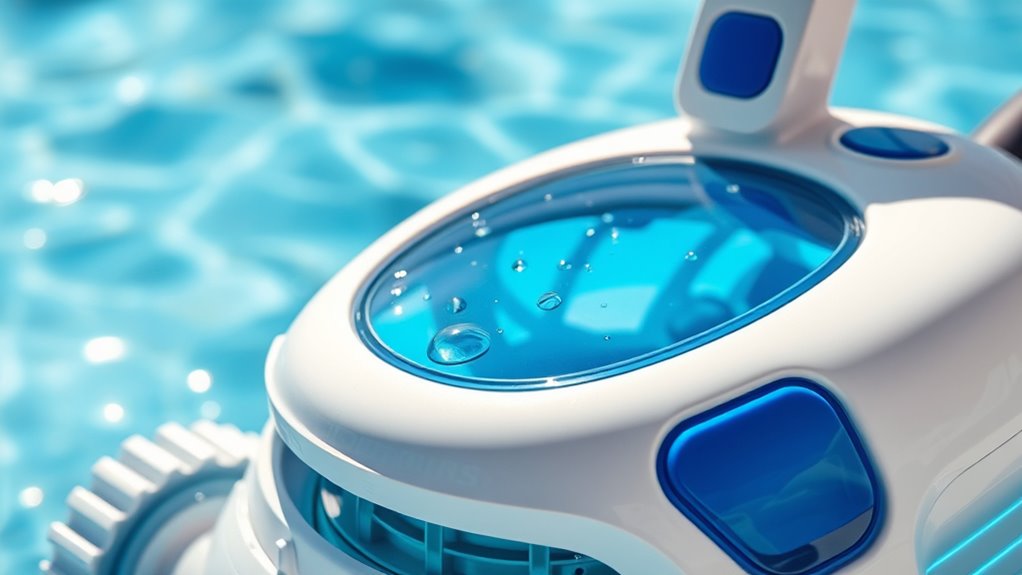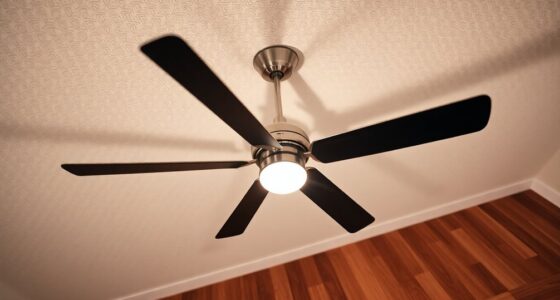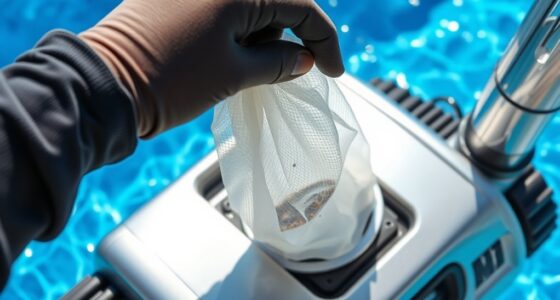To maintain your suction pool cleaner, regularly clean and inspect the skimmer basket, pump basket, and filter to prevent clogs. Check the suction line for blockages and clear any debris. Keep the hoses, swivels, and connection parts in good condition, replacing worn or damaged components. Also, verify the water level is proper and the cleaner moves freely. Consistent maintenance will keep your cleaner working efficiently—continue to explore for detailed tips to prolong its lifespan.
Key Takeaways
- Regularly clean and inspect skimmer baskets, filters, and water level to ensure proper water flow and debris removal.
- Check and clear the suction line of blockages using appropriate tools to maintain optimal suction.
- Remove debris gently from the cleaner, and inspect hoses, swivels, brushes, and wheels for wear or obstructions.
- Use proper tools like pool brushes, hose nozzles, and vacuums to dislodge debris and prevent buildup.
- Test the cleaner’s suction and replace worn parts promptly to ensure effective operation and extend lifespan.
Regularly Clean and Inspect the Skimmer and Pump Basket

To keep your suction pool cleaner working efficiently, it’s essential to regularly clean and inspect the skimmer and pump basket. A clean skimmer helps maintain proper water flow, which is vital for effective pool surface maintenance. When the skimmer basket becomes full of debris, it can disrupt the pool’s chemical balance by causing uneven circulation and algae growth. Check the basket frequently and remove leaves, insects, and dirt. Using a centrifugal separator can improve the efficiency of debris removal, ensuring the skimmer functions optimally. Additionally, inspecting the water circulation system can help identify any issues that might reduce overall pool performance. Regularly monitoring water flow rates can prevent potential problems before they affect pool clarity. Also, inspect the pump basket for obstructions that might hinder suction. Keeping these components clean ensures your pool’s chemicals distribute evenly, preventing imbalances that can lead to cloudy water or algae. Regular maintenance of the skimmer and pump basket not only extends your cleaner’s lifespan but also helps prevent issues caused by limitation factors that affect water clarity and overall pool quality.
Check and Clear the Suction Line for Obstructions
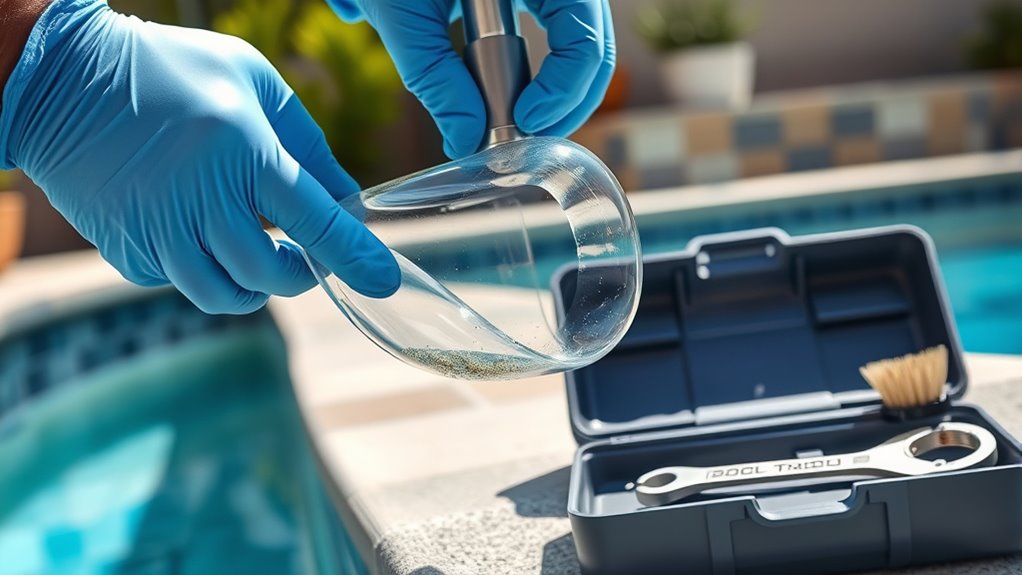
Start by inspecting the suction line for any blockages or debris that could restrict flow. Carefully remove any obstructions using the right tools to prevent damaging the line. Keeping the line clear ensures your pool cleaner works efficiently and extends its lifespan. Additionally, regularly appreciate the role of your pool cleaner as it helps maintain a clean and safe swimming environment. Incorporating automation in maintenance tasks can further streamline the process, ensuring consistent performance of your cleaner. Monitoring pool water chemistry can also prevent buildup that might clog the suction line, and understanding proper cleaning techniques can help you keep the system in optimal condition. Being aware of environmental considerations helps minimize impact on surrounding ecosystems and promotes sustainable use.
Inspect for Blockages
If your suction pool cleaner isn’t moving smoothly or seems less effective, inspecting the suction line for blockages is a crucial step. Start by turning off the pump and removing the hose to check for any obstructions. Carefully examine the entire suction line for clogs or debris that could hinder water flow. A clogged suction line reduces the cleaner’s efficiency and can cause unnecessary strain on your pump. To prevent future issues, regularly inspect and clear the line as part of clog prevention. Use a hose brush or a long, flexible tool to dislodge any debris. Ensuring the suction line is clear promotes ideal performance and extends the lifespan of your pool cleaner. Regular inspection and maintenance of the system help keep your pool cleaner running smoothly and efficiently, especially considering that component upgrades can enhance overall durability and performance. Additionally, using appropriate exfoliating acids can improve the skin’s texture, which can be beneficial if your pool cleaner is used in conjunction with water features that impact water quality.
A thorough check of your filtration system can also prevent buildup that might contribute to blockages and reduce strain on the cleaner.
Remove Debris Carefully
When removing debris from your suction line, it’s important to do so cautiously to avoid causing damage or pushing debris further into the system. First, turn off the pump to prevent water flow. Next, gently disconnect the suction line, taking care not to force or damage the fittings. Check for blockages, and clear any debris with a soft brush to prevent damaging the line or disrupting chemical balancing. Regular brush maintenance ensures smooth operation. Inspect the impeller and skimmer basket for lodged debris. Proper handling of debris also supports effective chemical balancing and prolongs your cleaner’s lifespan. Additionally, staying informed about automated pool cleaning innovations can help you optimize your maintenance routine. Being aware of the electric power capabilities of your equipment can also aid in troubleshooting issues efficiently. Using proper cleaning techniques can further enhance the longevity of your pool equipment. Regularly reviewing your system’s filter cleaning schedule helps maintain optimal performance. Finally, reassemble everything securely and run the system briefly to verify proper flow. Remember, careful removal prevents costly repairs and keeps your pool water clean and balanced. Maintaining your equipment properly can also improve home safety and health, ensuring a safer swimming environment for everyone.
Use Proper Tools
Using the right tools makes checking and clearing obstructions in your suction line safer and more effective. A pool brush or pipe cleaner helps dislodge debris blocking the suction line, restoring ideal suction power. A garden hose with a spray nozzle can flush out stubborn clogs, ensuring your cleaner functions smoothly. A pool vacuum or shop vac can also remove debris from hard-to-reach spots. Regularly inspecting and clearing obstructions prevents buildup that could disrupt your cleaning schedule. Maintaining steady suction power keeps your pool cleaner working efficiently, reducing the need for frequent repairs. Always use appropriate tools designed for pool maintenance, and follow safety precautions to avoid damage or injury. Staying proactive with these tools helps extend your cleaner’s lifespan and keeps your pool crystal clear. Understanding best pool maintenance practices can further improve your maintenance routine and efficiency.
Inspect and Replace the Pool Hose and Connection Parts
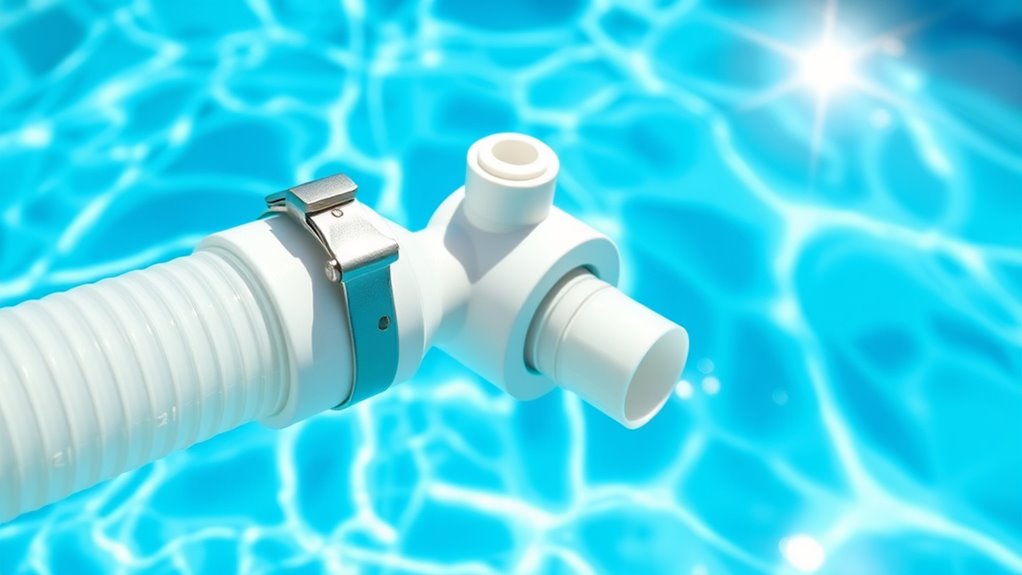
Regularly inspecting your pool hose and connection parts guarantees your suction cleaner operates smoothly. Over time, hoses can develop cracks or leaks, and connection parts may loosen or corrode, impairing performance. To ensure peak function: 1. Check for cracks, tears, or brittleness in the hose, and perform hose replacement if necessary. 2. Tighten or replace worn connection fittings to maintain proper suction. 3. Clean out any debris or mineral buildup in the connection parts to prevent blockages. 4. Inspect the hose clamps and secure them firmly to avoid disconnections during operation. Corrosion can compromise the integrity of connection parts and should be carefully monitored. Additionally, using high-quality replacement parts can extend the lifespan of your water filtration system, and understanding common issues like component corrosion can help prevent costly repairs. Regularly inspecting and maintaining these parts supports the overall performance of your pool system, ensuring consistent cleaning. Proper maintenance of these parts also helps sustain the effectiveness of your pool cleaner, ensuring it continues to operate efficiently.
Clean or Replace the Pool Cleaner Filter or Bag
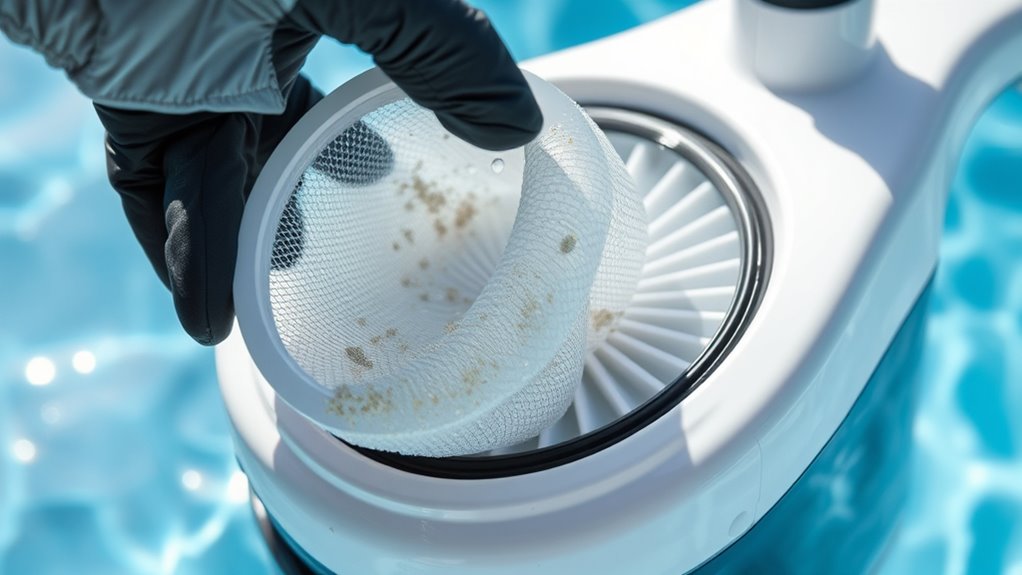
You should check your pool cleaner’s filter or bag regularly to keep it working efficiently. If you notice it’s dirty or clogged, it’s time to clean or replace it. Doing this guarantees your cleaner can effectively pick up debris without straining the motor. Regular maintenance, including filter replacement, is crucial for optimal performance. Incorporating protective styling benefits like crochet or loc styles can also help keep your hair healthy during routine upkeep.
Inspect Filter Regularly
Because a clogged filter can reduce your pool cleaner’s efficiency, it’s important to inspect it frequently. Regular filter maintenance guarantees ideal suction and prevents damage. When inspecting, look for debris buildup that can block water flow. Check the filter or bag for tears or holes, which compromise seal integrity. Clean filters thoroughly with a hose if they’re dirty, and replace them if damaged. Here’s what to do:
- Remove the filter or bag and inspect for debris and tears.
- Clean the filter with a gentle spray, ensuring no residue remains.
- Check the seal for cracks or wear, replacing if necessary.
- Reinstall the filter securely, ensuring proper seal integrity for effective operation.
Consistent inspections keep your cleaner running smoothly and extend its lifespan.
Replace When Necessary
Over time, your pool cleaner’s filter or bag can become worn or blocked, reducing its effectiveness. If you notice decreased suction or your cleaner missing debris, it’s time to replace or clean the filter or bag. Regularly maintaining your suction system ensures ideal pool maintenance and prevents strain on your cleaner’s motor.
| Worn Filter | Clogged Bag | Reduced Suction | Ineffective Cleaning |
|---|---|---|---|
| Damaged parts | Obstructed flow | Poor debris removal | Frustration with pool upkeep |
Replacing your filter or bag when necessary keeps your suction pool cleaner working efficiently, saving you time and effort. Stay attentive, and don’t hesitate to swap out worn components for a pristine, clear pool.
Ensure Proper Movement and Function of the Cleaner
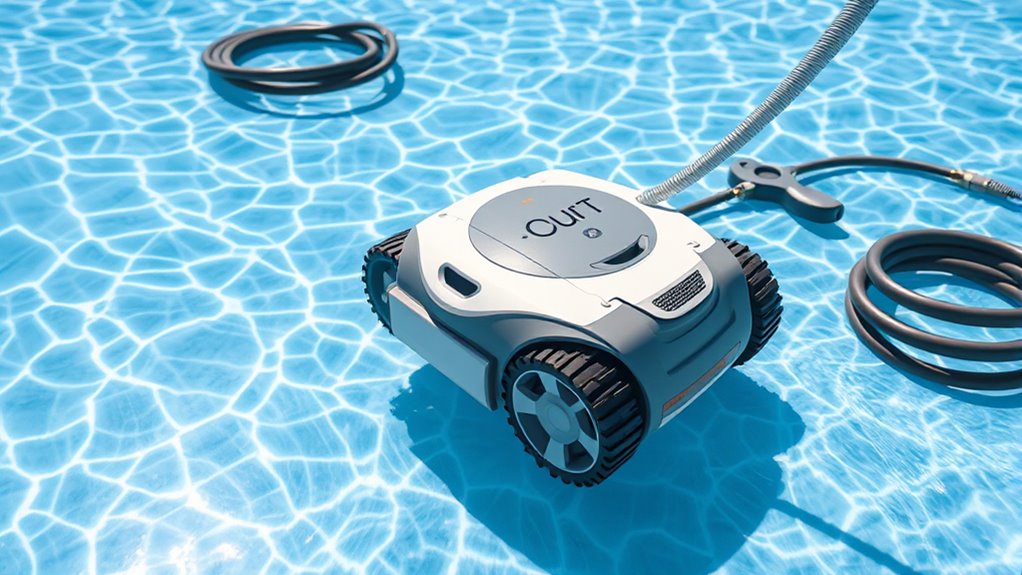
To keep your suction pool cleaner moving smoothly and functioning effectively, it’s essential to regularly inspect its components and guarantee they are free of obstructions. A consistent cleaning schedule helps prevent debris buildup that can hinder movement. Additionally, review the hoses and swivels for twists or blockages. Implement troubleshooting tips like checking for clogs or worn parts if the cleaner isn’t moving properly.
Consider these steps:
- Inspect and clear hoses for obstructions.
- Ensure the swivel joint rotates freely.
- Check the brushes and wheels for wear and replace if needed.
- Test the cleaner’s suction to confirm ideal performance.
Regular maintenance keeps your cleaner operating efficiently and prolongs its lifespan.
Maintain the Pool Water Level for Optimal Suction
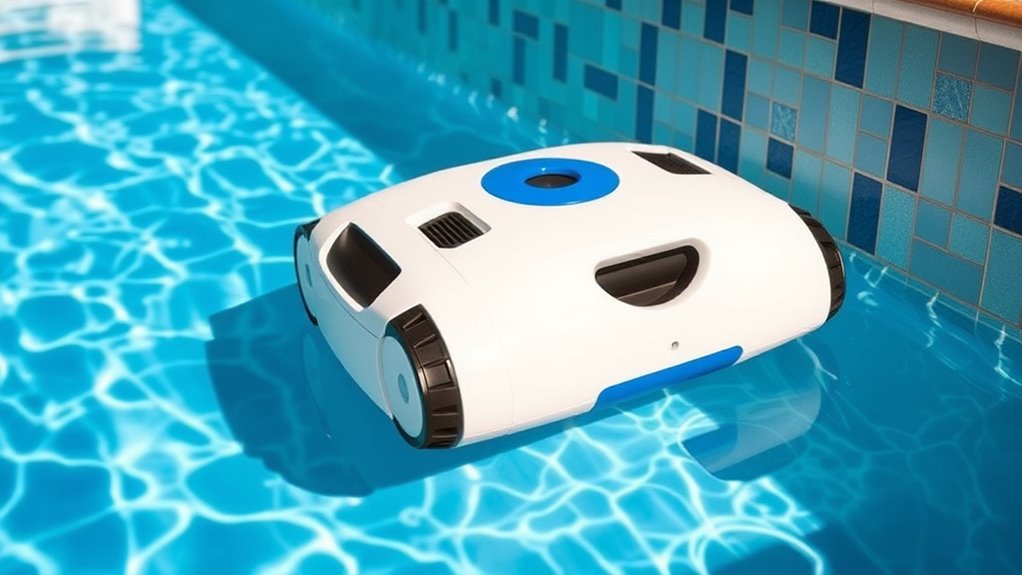
Maintaining the correct pool water level is essential for your suction cleaner’s performance. When the water is too low, the cleaner can lose suction, reducing its effectiveness. Conversely, if the water is too high, the skimmer may not function properly, impacting water chemistry and overall pool health. Regularly check and adjust the water level, keeping it near the middle of the skimmer opening. Proper pump maintenance also plays a role; a well-maintained pump ensures consistent water flow and suction power. Additionally, maintaining balanced water chemistry prevents debris buildup that could clog the cleaner or hinder suction. By keeping the water level ideal and your pump in good shape, you ensure your suction pool cleaner works efficiently, prolonging its lifespan and keeping your pool pristine.
Store the Cleaner Properly During Off-Season Periods
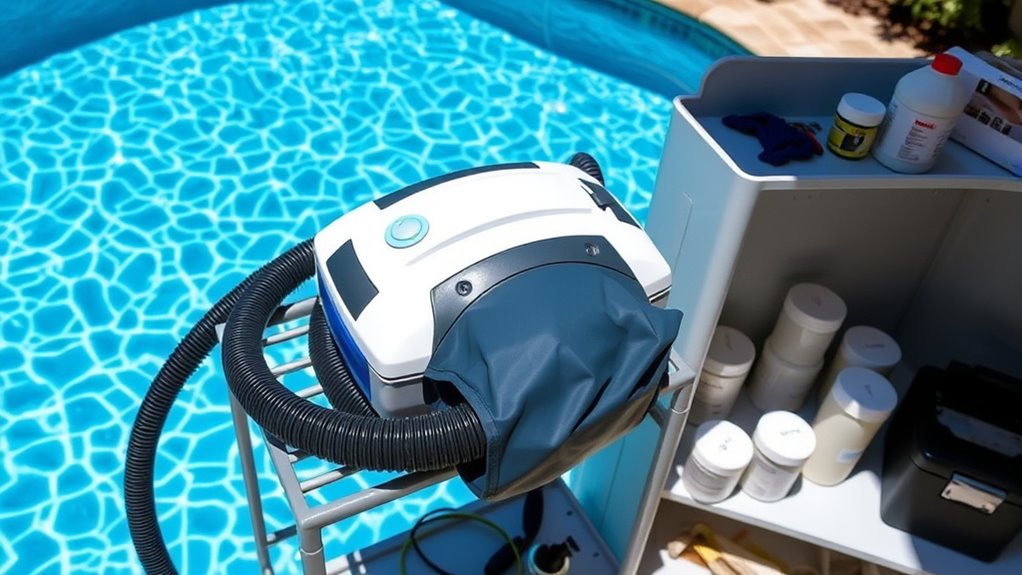
Proper storage of your suction pool cleaner during the off-season helps preserve its performance and extend its lifespan. To guarantee it’s ready when you need it again, follow these storage tips for seasonal maintenance:
- Rinse the cleaner thoroughly to remove dirt, debris, and chlorine residue.
- Dry all parts completely to prevent mold and corrosion.
- Store in a cool, dry place away from direct sunlight to avoid material degradation.
- Coil hoses loosely and avoid tight bends to prevent damage.
Frequently Asked Questions
How Often Should I Replace the Suction Pool Cleaner’S Wheels or Brushes?
You should replace your suction pool cleaner’s wheels or brushes as part of your maintenance schedule, typically every 4 to 6 months, depending on usage. Keep an eye on wear and tear; if they look worn or damaged, substitute the necessary replacement parts promptly. Regular maintenance helps your cleaner perform efficiently, extends its lifespan, and ensures your pool stays clean. Staying proactive with these replacements keeps your pool in top condition.
Can I Use Household Cleaning Products to Clean the Pool Cleaner?
Think of your pool cleaner as a trusted workhorse that needs gentle handling. You shouldn’t use household chemicals to clean it, as they can damage the delicate parts and reduce efficiency. Instead, stick to cleaning hacks like rinsing with fresh water or using a mild soap. This keeps your cleaner in top shape, avoiding harsh chemicals that can cause more harm than good, ensuring it works smoothly for longer.
What Are Signs That My Pool Cleaner’s Motor Is Failing?
If your pool cleaner’s motor is failing, you’ll notice issues like reduced cleaner performance, strange noises, or inconsistent movement. These signs point to pool motor issues that may need attention. You might also find that the cleaner isn’t picking up debris as effectively or stops working altogether. Addressing these signs early can prevent further damage and guarantee your pool stays clean, keeping your pool motor running smoothly.
How Do I Troubleshoot if the Cleaner Is Not Moving Properly?
If your pool cleaner isn’t moving properly, start with water flow troubleshooting. Check for clogs in the hoses or skimmer basket, as blockages can impede pool cleaner mechanics. Make certain the hose connections are secure and the skimmer is functioning correctly. Adjust the float or weight to improve movement. Regularly inspect for debris or damage, which may hinder performance. These steps help identify issues and restore proper pool cleaner mechanics.
Is It Necessary to Calibrate the Cleaner’s Sensors Regularly?
You might wonder if you need to calibrate your pool cleaner’s sensors regularly. Sensor calibration helps guarantee sensor accuracy, so your cleaner detects obstacles and navigates efficiently. While some models require periodic calibration, others are designed to maintain their sensor accuracy automatically. Check your cleaner’s manual for specific instructions, but generally, regular calibration isn’t necessary unless you notice issues with sensor performance or erratic movements.
Conclusion
By keeping your suction pool cleaner in tip-top shape, you’re fundamentally giving it a gentle tune-up that makes it run like clockwork. Regular cleaning and inspections are the secret sauce to a sparkling pool without headaches. Think of your cleaner as a loyal companion—tend to it well, and it’ll keep your pool crystal clear, making swimming days feel like a breeze. With a little care, your pool’s best helper will stay ready for every splash and swim.
